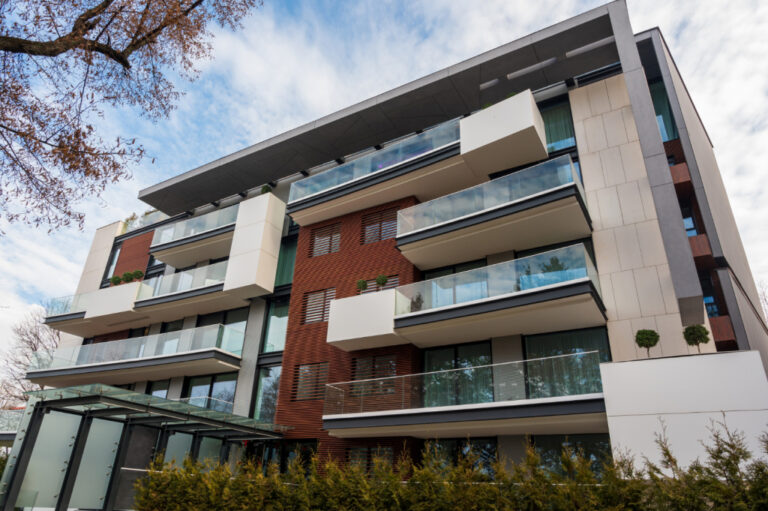Image by frimufilms on Freepik
The captivating charm of Southern California makes it an attractive location for individuals looking to invest in real estate.
The thriving economy, stunning shorelines, tranquil communities, superb shopping districts, and exceptional dining options all contribute to the appeal of its local real estate market, which is highly enticing to potential buyers and investors.
Among the various investment opportunities in Southern California are multifamily properties that have become popular for families or individuals looking for new homes.
These real estate properties also attract many savvy investors seeking financial stability and long-term growth potential.
However, navigating the multifamily property market in Southern California requires careful consideration and strategic planning beforehand.
In this article, we will cover everything there is to know on how to buy a multifamily property in Southern California.
What is a Multifamily Property?
A multifamily property is a single residential home with multiple housing units to accommodate more than one family living separately.
These homes can range from two-unit duplexes to high-rise apartment buildings with up to four accommodations.
Suppose you plan on buying or investing in a multifamily home. In that case, you must consider several steps and factors, and you probably have many questions about how to purchase a multifamily property.
Here is a comprehensive guide to help when buying a multifamily home in Southern California.
Research and Preparation
Investing in multifamily properties can be rewarding as it offers a potential for stable cash flow, long-term appreciation, and real estate portfolio diversification.
However, thorough research and preparation are vital, similar to purchasing or investing in any other real estate property, as these are key factors to thrive in the multifamily property market.
Define Your Multifamily Investment Goals
It is only possible to achieve your goals if you first define them. If you understand your investment goals, it will help you make informed decisions throughout the purchasing process.
Consider several things, such as your expected return on investment and your long-term financial objectives. Do you want a steady cash flow or more significant appreciation potential?
However, remember that your investment goals should be both reasonable and attainable.
Understand the Local Market Dynamics
Understand thoroughly the local real estate market in Southern California. Research and analyze trends, property values, rental rates, vacancy rates, and economic indicators specific to SoCal.
Get an idea of how to acquire a multifamily property, particularly in Southern California.
You should also determine the demand for multifamily properties and identify neighborhoods that have potential growth and will give an investment return.
Learn About the Different Types of Multifamily Property
Research each type of multifamily home equally to see which will best fit your financial goals.
While researching, you may discover that a particular property type better suits your goal or has a better opportunity in the local rental market than you previously thought.
Residential duplexes, triplexes, and fourplexes are the common multifamily properties in SoCal.
Establish a Budget
Although multifamily investment has numerous benefits, the upfront fees are undeniably pricey. So, it is crucial to determine your budget by assessing your financial capacity and resources.
Do some research about factors you will consider in the budget, such as down payment requirements, closing costs, carrying costs, renovation or maintenance expenses, and ongoing operating costs.
Set a realistic budget, as it would also be better to overestimate your expenses to be ready for unexpected costs and ensure you can comfortably afford the property.
Network and Learn from Others
Take advantage of networking opportunities within the real estate community. Attend local real estate events, join investment groups or forums, and connect with experienced investors and professionals.
Engaging in these activities allows you to gain valuable insights, learn from other’s experiences, and identify off-market opportunities.
Property Search and Analysis
Once you have identified your goals, gathered enough information from research, and planned how to buy a multifamily property in Southern California, your journey in finding potential multifamily properties that meet your goal will start.
As you search for a property, you will also analyze them to determine its financial performance.
Here is a short list of the comprehensive things involved while searching and analyzing multifamily property.
Search For Multifamily Homes in Listing
When searching for a multifamily home, the first step is to search for these properties for sale. You can find them by looking at listings, which can be found online nowadays.
By browsing the listings, you will also learn about the information of multifamily homes for sale, and you can sort out the options available to you and start narrowing down your choices.
Working with a Real Estate Agent
Once you’re ready to start your search, finding a Southern California real estate agent can also be beneficial that will assist you in searching for multifamily properties that fit your criteria.
They have access to a database of homes for sale and can provide details and suggestions about each.
Additionally, they can set up house viewings for you so you can see the properties in person and better understand what they’re like.
The search process can be significantly sped up and made more efficient by having a real estate agent on your side.
Search For Neighborhood
The mantra “location, location, location” is commonly heard and may sound overused, but it is crucial in real estate investment, even more so when investing in multifamily homes.
When purchasing a multifamily home, it is a good idea to search for neighborhoods that are well-maintained and experiencing growth, offering good returns on investment.
These neighborhoods should have a high demand for real estate, meaning people want to live there and rent or buy properties.
Focusing on such neighborhoods increases your chances of finding properties more likely to attract tenants or buyers and generate higher profits for you in the long run.
Furthermore, purchasing a multifamily property will undoubtedly be advantageous in an area that is “up and coming.”
It means buyers should specifically consider nearby attractions and amenities, school district ratings, walkability, public transportation, proximity to businesses, public parking, the condition of other homes, and future projects planned.
Evaluate the Number Of Units
Identifying the units a multifamily property holds is another essential thing to consider when you evaluate multifamily properties.
By knowing the unit number, you can get a clearer picture of the property and understand how it affects the potential income you could receive from it.
When searching for a multifamily property, one important factor to consider is the expected money each unit in the property can generate.
This money is called cash flow and is crucial because it helps determine whether your property price is reasonable.
For instance, the rent you collect from your tenants should be sufficient to cover the mortgage on the property or need to be even more than the mortgage payment. There will also be times when some units are vacant, which usually happens.
However, rents in Southern California are pretty high, so even if you have a few empty units, the remaining rented units can still generate cash flow to cover the mortgage expenses.
Sometimes, you might even have extra money to save for unexpected expenses or emergencies.
Price Range
Apart from the initial price of the property, buyers should also understand the costs they will have to bear when acquiring a multifamily property.
To properly evaluate multifamily properties, consider all the additional expenses, which range from property taxes to renovation costs and everything in between.
It is crucial to assess and compare every expense to the potential profits. If you still have a positive outcome in terms of profit after considering all the costs, you may have found a promising multifamily investment opportunity.
However, if the numbers show that the expenses outweigh the potential profit, it would be advisable to continue searching for other multifamily properties for a better investment option.
Property's Condition
Another factor to consider is the property’s condition you will purchase.
Other than the easily noticeable things, like mold, fire damage, and water damage, it is essential to evaluate other factors, such as the quality of the windows, the building’s insulation, and the state of the piping and wiring.
If any repairs must be made, consider the cost as they add to the property’s overall price.
Financing and Due Diligence

Image by master1305 on Freepik
After finding a multifamily property and jumping to negotiation and payment, some steps, called financing and due diligence, still need to be done.
Financing covers the process of getting the necessary funds to purchase the property while
Due Diligence is the in-depth investigation and analysis.
The latter is conducted before finalizing the transaction to avoid risks and ensure the property’s suitability for investment.
Financing Options
When financing a multifamily property, several options are available to prospective buyers.
Understanding these options and selecting the most suitable one for your specific situation is crucial. Here are a few standard financing options in Southern California:
Government-Backed Loans
The U.S. federal government insures or backs government loans. Federal Housing Administration (FHA) and the Department of Veterans Affairs (VA) provide loan options specifically designed for multifamily properties.
FHA loans are mortgages with less credit and down payment requirements, making them more accessible to more individuals and ideal for first-time buyers.
To be eligible, you will need to have a minimum credit rating of at least 580 and a 3.5% down payment.
The drawback of an FHA loan is that you must pay monthly mortgage insurance after paying an upfront mortgage insurance charge that typically amounts to 1.75% of your total loan amount.
On the other hand, VA loans cater to eligible military personnel, veterans, national guard personnel, reservists, and qualifying surviving spouses.
VA loans do not set a minimum credit score requirement. Most lenders ask for other preconditions, such as a Certificate of Eligibility (COE), to validate your qualifications for the loan.
Conventional Loans
Private lenders insure conventional loans instead of being backed or guaranteed by the government. Lenders evaluate credit history, income, and property value to determine loan eligibility.
There are two types of conventional loan options buyers can choose from:
Conforming Conventional Loans – these loans adhere to the guidelines established by the Federal Housing Finance Agency (FHFA), which can be bought by Freddie Mac and Fannie Mae.
These loans limit the amount of money you can borrow, and in most parts of the United States, the following are in effect:
| Property Type | Borrowing Limit |
|---|---|
| Two Units | $929,850 |
| Three Units | $1,123,900 |
| Four Units | $1,396,800 |
- Non-Conforming Conventional Loans – it does not follow the guidelines specified by the FHFA. For instance, Jumbo loans are used to finance real estate that costs more than the conforming loan limitations.
Commercial Loans
Commercial loans, which are available through banks, credit unions, and private lenders, are tailored for larger multifamily properties or investors with complex financing needs.
These loans often have stricter qualifications and higher down payments.
Due Diligence Procedure
Conducting thorough due diligence is essential before finalizing the purchase of a multifamily property.
The process involves a comprehensive investigation of the property’s financial, legal, and physical aspects.
Here are key considerations during due diligence, and conducting these assessments can help you make an informed decision about the multifamily property you intend to purchase.
Financial Analysis
Evaluate the property’s financial records, including income statements, rent rolls, and expense reports.
Scrutinize the historical and projected cash flow, occupancy rates, and potential rental increases.
Assess the property’s financial viability and determine if it aligns with your investment goals. In most cases, when people want to borrow money to buy a property, they usually start by looking at the property’s financial records.
It includes income statements, rent rolls, expense reports for the past year (T-12), and the profit and loss statements for the last three years (P&L) to make future performance predictions for the property.
However, the forecast is not enough to make a convincing decision about how profitable the multifamily property will be.
That’s why you should consider hiring a real estate consulting firm to analyze the property’s financial records from the past carefully.
The analysis helps identify any concerns and ensures that the predictions about the property’s future performance are generally accurate.
Market Analysis
Before purchasing, evaluate the local market dynamics, including supply and demand trends, rental rates, vacancy rates, and potential future developments.
Understand the neighborhood’s desirability and growth prospects. It will help determine how many people are likely to rent or buy units in your multifamily property, how much it is worth, how quickly it will be occupied, and other important information.
The market analysis report is usually created by an independent company specializing in real estate consulting.
Legal Review
Hire an attorney to review legal documents, such as leases, contracts, property titles, and zoning regulations.
They will help you ensure compliance with local laws, understand any existing or potential legal disputes, and verify the property’s zoning permits and restrictions.
Lease Audit
A lease audit is when a third party examines the current leases for the multifamily property.
The property management business in charge can handle this, but you may wish to hire a new company if they are biased.
A list of tenants and their rental payments, known as the rent roll, is typically examined first during a lease audit.
But the audit goes further than that. It will go over every detail of every contract, including tenant billing schedules, any overdue or unpaid rent, and any units leased for a discount or given for free to a property manager.
A lease audit is essential to ensure that the leases are followed and that no problems could negatively impact the property’s revenue.
Title Report
Multifamily lenders typically want a title report to verify the legitimacy of the property’s title.
It ensures that no competing legal claims to the property are made by former owners or parties that have previously performed work on the property, such as mechanic’s liens.
A title report is typically necessary to obtain owner’s title insurance. Most often, a site survey of the property is also required to validate the precise property borders and the size of the lot before title reports and title insurance.
Risk Assessment
Identify and evaluate potential risks associated with the property, such as environmental liabilities, insurance coverage, property management challenges, or regulatory changes that may impact future operations or expenses.
Negotiation and Purchase
Once you have identified a promising multifamily property in Southern California and completed your due diligence, the next crucial step is the negotiation and purchase process.
This stage requires strategic decision-making, effective communication, and careful attention to detail. Here are some of the things you need to accomplish during this phase:
Making an Offer
Before entering into negotiations, it is essential to determine a fair and competitive offer price based on your analysis of the property’s value and market conditions.
Submitting a well-prepared and professionally presented offer can make a significant impression on the seller.
Consider including relevant contingencies, such as financing and property inspection, to protect your interests during the negotiation.
Effective Communication
Negotiations involve active communication and understanding of the needs and requirements of both parties.
Establishing a connection with the seller or their representative can help create trust and make the process go more smoothly.
Clearly express your interests, priorities, and requirements while actively listening to the seller’s perspective. By having open communication, you can explore mutually beneficial solutions.
Flexibility and Compromise
Negotiations often require a certain degree of flexibility and willingness to compromise.
Understand that both parties have their objectives, and finding a middle ground can lead to a win-win situation.
Be prepared to make compromises on non-essential terms to secure more favorable conditions on crucial aspects such as price, financing terms, or contingencies.
Contingencies and Due Diligence
Contingencies must be included in the purchase agreement to safeguard your interests and allow you to perform thorough due diligence on the property.
A few typical contingencies include reviewing financial information, legal documents and getting financing permission.
Defining these contingencies and establishing appropriate timetables for their fulfillment will need close collaboration between you and your real estate agent.
Property Inspection and Evaluation
Once your offer is accepted and contingencies are in place, inspect the property thoroughly by hiring qualified professionals.
It includes home inspectors and contractors to evaluate the property’s physical condition and identify potential issues.
They will assess the property’s overall condition, including its structure, electrical, plumbing, and HVAC systems, common areas, and individual units, for any problems or necessary repairs and estimate renovation or repair costs.
The inspection results may allow you to renegotiate the purchase price or request repairs before closing.
Finalize the Transaction
When all the contingencies are fulfilled, and you are now satisfied with the property, you can proceed with finalizing the transaction.
Work with the real estate agent you hired, the attorney, and the title company to correctly complete all legal requirements and documentation. It may include title searches, insurance, property surveys, and other necessary paperwork.
Once all parties have signed the required documents, the transaction can proceed to the closing stage.
Post-Purchase Management
Now you know how to navigate the complex process of how to buy a multifamily property.
Once your keys to your multifamily property in Southern California have been obtained, the property ownership journey begins!
Successful post-purchase management is crucial for maximizing returns and ensuring tenant satisfaction, which maintains the investment’s long-term viability.
Post-purchase management involves the following:
Property Maintenance and Upgrade
Regular and proactive maintenance is crucial for maintaining the property’s value and minimizing costly repairs.
Develop a maintenance schedule that includes routine inspections, promptly addressing repairs, and conducting preventive maintenance to ensure that the property remains in optimal condition, reducing turnover and attracting potential tenants.
Furthermore, property owners should consider upgrades and value-add options to maximize the property’s value and attract quality tenants.
It may include renovating common areas, updating amenities, improving energy efficiency, or enhancing curb appeal.
Rent Collection and Financial Management
Consistent and timely rent collection is vital for maintaining steady cash flow and meeting financial obligations.
Property owners should establish clear rent collection procedures and ensure tenants know their responsibilities. Online rent payment options can also streamline the process and reduce late payments.
Additionally, active financial management contributes to the property’s economic success, including budgeting, tracking expenses, and optimizing revenue streams.
Professional Property Management
Managing a multifamily property can be time-consuming, especially for owners with multiple properties or limited experience.
Professional property management services can alleviate the burden and provide expertise in tenant screening, lease management, marketing, and day-to-day operations.
Property owners should carefully evaluate potential property management companies, ensuring their goals align and they possess a solid track record in the local market.
Tenant Relations
Effective communication, responsiveness to tenant concerns, and a proactive approach to addressing maintenance and repair issues contribute to tenant satisfaction.
Property owners should strive to create a welcoming and comfortable living environment, enabling a sense of community and promptly addressing tenant needs.

Conclusion
Buying a multifamily home in Southern California is an excellent investment opportunity but requires careful research, preparation, and strategic planning.
Understanding your investment goals and the local market dynamics is crucial for making informed decisions.
Thoroughly researching the different types of multifamily properties and establishing a realistic budget is equally important.
When searching for a multifamily property, you can browse listings, work with a real estate agent familiar with the Southern California market, and focus on neighborhoods with growth potential.
Evaluating the number of units, price range, and the property’s condition will also help determine its financial performance and suitability for investment.
As a buyer, financing options such as conventional, government-backed, and commercial loans should be carefully considered.
Due diligence is also necessary to assess the property’s financial, legal, and physical aspects.
During the negotiation and purchase phase, making a fair offer based on market conditions, maintaining effective communication, and being flexible and willing to compromise can lead to a successful transaction.
Understanding all these important procedures and information will likely lead you to close a successful deal and bring you one step closer to your long-awaited multifamily property!
Ready to make smart real estate investments? I am here to listen, understand, and guide you toward the best opportunities in the market.
With an extensive client base of new and seasoned investors across all property types, I am confident I can help you navigate the multifamily market in SoCal!
You can contact me by calling (213) 453-2572 or sending an email at realtorjackpatel@gmail.com to start your journey to profitable investments!
Stay connected with me through social media for the latest real estate insights and opportunities and stay ahead of the game.

Image by KamranAydinov on Freepik
Frequently Asked Questions
What is the cap rate for multifamily in Southern California?
In Southern California, the market cap rate is 3.9% on average, which is lower than the national average of 4.9%.
What state has the most multifamily properties?
New York now has the most multifamily houses and is located throughout the five boroughs.
Despite the state’s many properties and the high demand, prices are pretty high, making it difficult for newcomers to enter the market.
What type of real estate is multifamily?
Multifamily properties are residential homes with more than one housing unit to accommodate multiple families or individuals separately within a single building or complex.








